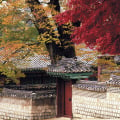It's the most sumptuous palace. It offers the most magnificent vision of Korean royal architecture in all its splendour.
Listed as a UNESCO World Heritage Site, it's undoubtedly one of Seoul's most beautiful palaces. In any case, a visit is a must!
Built in 1405 by King Taejong of the Yi dynasty as an auxiliary palace, Changdeokgung Palace was completed in 1412. It was completely destroyed by the Japanese in 1592 during a series of invasions. Rebuilt from 1607 to 1610, it became the seat of royalty in 1615. A fire destroyed it again almost entirely in 1623 during an attempted coup d'état. Once rebuilt in 1647, the kings lived there without interruption until the end of the dynasty. It burned down several times, including Daejojeon Hall in 1917. To replace some of the destroyed buildings, structures were moved from the Gyeongbokgung, including the royal apartments. Although around half of the buildings have been lost to fire or the Japanese, 13 are still well preserved and form a magnificent ensemble.
These include the great Donhwamun Gate, the Injeongjeon Hall, the throne room where the king gave audiences, received ambassadors and presided over banquets, and the Seongjeongjeon Hall, restored in 1647, from which the king administered the kingdom and which is said to be the only building in Korea to have kept its blue-green tiles intact. The Heuijeongdang and Daejojeon halls were part of the inner palace and served as private quarters for the royal family. The former was built in 1496 and destroyed several times until it was rebuilt in 1920 using materials from the Gangnyeongjeon Hall of the Gyeongbokgung Palace, dismantled by the Japanese. At that time, it was electrified and the decoration westernized. Daejojeon was the Queen's residence. It was completely burnt down in 1917, then rebuilt from a building taken from the Gyeongbokgung. Six kings died here, including the last, Sunjong, in 1926. You can see Ochago, the royal garage, a former office for senior royal officials transformed by the Japanese into a garage for automobiles and palanquins. Away from the other buildings, the Nakseonjae house was built in 1846 for the royal concubines. Queens came here to mourn their deceased kings. The last queen, Yunbi, began her 40-year mourning period here in 1926. It was also here in 1963 that the last son of King Gojong, Sunjong's half-brother, was allowed to return from exile in Japan.
Good to know: admission is free for those wearing a hanbok!









